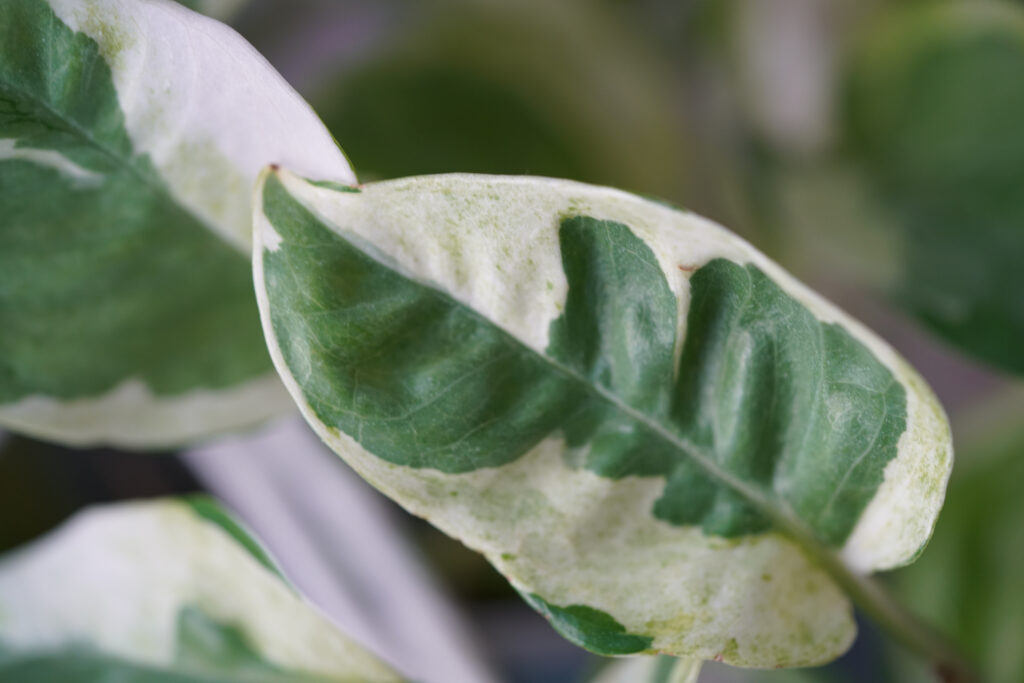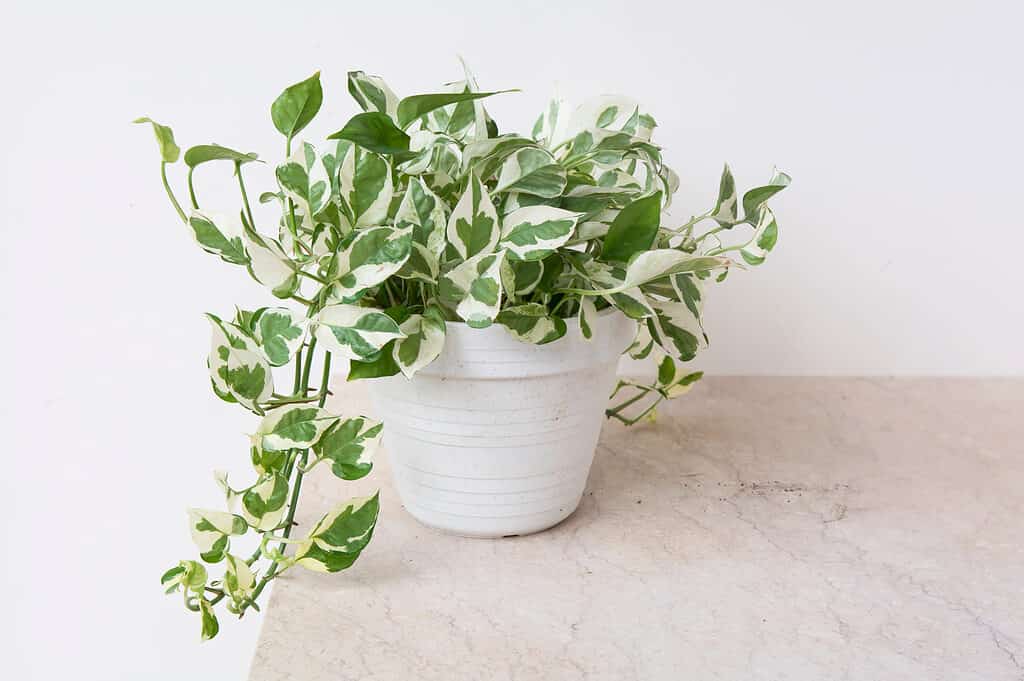↓ Continue Reading To See This Amazing Video
Pothos plants are known for their very unique and abundant varieties. There are pothos cultivars out there that are completely green, mostly white, or covered in a mix of different colorful stripes and speckles.
Two popular varieties known for their unique colors are the neon pothos and the N’joy pothos. These two plants are often mistaken for one another due to their similar names, but these varieties could not be more different from one another in terms of appearance.
Let’s take a look at some important differences between these two pothos cultivars and how you can grow and care for your very own neon pothos or N’joy pothos at home as houseplant.
Comparing Neon Pothos vs. N’Joy
| Neon Pothos | N’Joy Pothos | |
|---|---|---|
| Classification | Epipremnum aureum ‘Neon’ | Epipremnum aureum ‘Njoy’ |
| Alternative Names | N/A | N/A |
| Origin | South Pacific Islands, southeastern Asia | South Pacific Islands, southeastern Asia |
| Description | A variety of golden pothos known for its vivid neon-green leaves with little to no variegation. | A variety of the golden pothos, derived from the marble queen pothos cultivar, that is known for its unique pure-white and dark green variegation. |
| Uses | Houseplant | Houseplants |
| Growth Tips | Always plant this variety in well-draining soil to avoid root rot. | Give this variety plenty of bright and indirect light to maintain its vibrant leaf variegation. |
| Interesting Features | This plant can handle low lighting conditions, as it does not have any variegation that will be lost in low light. | This variety has chunky deep green and white variegation, which differs from the typical striped variegation of other pothos varieties. |
The Key Differences Between Neon Pothos and N’Joy
The neon pothos and the N’joy pothos are the same species of plant. However, they are different varieties that have different colorations worth noting.
To start, the neon pothos plant is not a variegated variety. This means that its leaves are usually one solid color, rather than a mix of different colors and patterns. The neon is unique in that it has very bright neon green leaves, compared to the more golden-green hue of its base variety, the golden pothos.
The N’joy pothos is a variegated variety. It is known for having large chunks of white or cream-colored variegation against a green base color. Specifically, the N’joy pothos tends to have variegation around the edges of each leaf with the deep green hue located more towards the center of each leaf.
Another difference between these two plants is their sunlight needs. Both plants do well in bright, indirect light. However, the N’joy pothos needs bright, indirect light or else it will lose its variegation and unique patterns. The neon pothos can be kept in low light without losing any of its color.
Other than the above differences, these two pothos varieties have very similar water, humidity, temperature, lighting, soil, and overall care requirements and needs.
Neon pothos leaves (pictured) are easily identified by their vibrant lime-green hue.
©iStock.com/NooUma
Neon Pothos vs. N’Joy: Classification
The botanical name of the neon pothos is Epipremnum aureum ‘Neon’. The botanical name of the N’joy pothos is Epipremnum aureum ‘Njoy’. Both of these varieties share the same species and are part of the plant family known as Araceae. They are close relatives of philodendrons, which are often mistaken for pothos plants.
Neon Pothos vs. N’Joy: Description
A golden pothos variant notable for its lack of variegation is the neon pothos. The “neon” name for this cultivar refers to its neon-green foliage. The neon pothos is often regarded as a very low-maintenance indoor plant. They have vines that can reach lengths of up to 10 feet when grown properly indoors. A neon pothos plant can grow up to one foot each month under ideal conditions. While this unusual cultivar will stay lime green for a considerable amount of time in low light, if not given indirect, intense sunshine, it can start to become a deeper green hue.
Since it was first introduced to the plant trade about a decade ago, the marble queen pothos cultivar known as the N’joy pothos has grown to be highly prized for its ease of care and unique look. It’s one of the easiest plants to grow at home, just like all pothos tend to be. A wonderful addition to any indoor garden, the N’joy pothos is a vining plant with eye-catching white and green variegation on its leaves. Its white-cream variegation tends to hug the edges of each of its deep green leaves. N’joy pothos plants, like all other pothos family members, are very good at removing toxic chemicals like formaldehyde and benzene from indoor air.
 The variegation of the N’joy pothos’ leaves (pictured) tend to be cream-white and hug the edges of each leaf.
The variegation of the N’joy pothos’ leaves (pictured) tend to be cream-white and hug the edges of each leaf.
©iStock.com/Helena Bezold
Neon Pothos vs. N’Joy: Uses
Neon pothos and N’joy pothos plants are primarily used for ornamental purposes as indoor houseplants. They are both popular selections for tropical plant collections. Just as well, both plants are great for indoor air purification, though it will take a high volume of plants to purify indoor air in the average home.
Neon Pothos vs. N’Joy: Origin
All pothos are native to the islands of the South Pacific and a few areas of southeastern Asia. The neon pothos might naturally occur in nature, but there is little information about who bred this unique variety if anyone did. The N’joy pothos was intentionally bred using the naturally occurring mutation found in marble queen pothos varieties by Ashish Hansoti back in 2002.
Neon Pothos vs. N’Joy: How to Grow
Pothos plants can reach enormous sizes and crawl and climb all over the place in tropical forests where they are native. Neon pothos or N’joy pothos can be grown outdoors in a shaded area as a ground cover or scrambling vine if you happen to live in USDA hardiness zones 10 and 11. If you don’t live in these zones, opt to keep your pothos inside.
The upkeep of any pothos is quite easy. These plants thrive in a variety of settings. They can be grown in dry soil or even in fishtanks. Pothos in general can be grown in low light conditions as well as consistently bright, indirect sunshine. These plants perform nearly identical in organic matter-poor soil as they do in organic matter-rich soil.
Because these plants can do very well in low sunshine, pothos plants are an excellent addition to your bathroom or workplace. But to prevent the regression of their leaves, we advise keeping both your neon pothos and N’joy pothos in better lighting settings. Pothos perform well in a range of lighting situations, although they struggle in direct sunshine.
If the light is too low, a pothos that is heavily variegated with white, like the N’joy pothos, can not grow as well or lose its variegation. The neon pothos could potentially become darker as well. Only the green portions of the leaves can provide energy for the plant and produce chlorophyll, thus it must be able to obtain enough light to do so. Otherwise, its development will be slowed and the leaves will turn an even darker shade of green to make up for the lack of light.
Pothos can be grown in soil or in water, which presents many opportunities to get creative with your plant. From a mother plant, cuttings can be removed, rooted in water, and kept long-term in water as a houseplant. This is useful for placing a pothos plant in a water jug in difficult-to-reach places where it can stay undisturbed as long as water is in the jug.
On the other hand, pothos can also be grown in soil and can withstand brief periods of soil dryness with no negative impact on the plant. Though strangely enough, cuttings that are begun in one type of growth media have trouble transitioning to another. So, a pothos plant that was propagated in soil will have a difficult time flourishing when transplanted to water, and a cutting of a pothos that was started in water will struggle to thrive in soil, especially if it has spent a lot of time growing there.
While fertilizing your pothos plant approximately once every three months can speed up its growth, the majority of plant parents out there find that their plants grow rapidly enough without it. This is a major no-brainer plant that is perfect for beginners!
 N’joy pothos (pictured) make excellent houseplants but will need indirect bright light to maintain their leaf variegation.
N’joy pothos (pictured) make excellent houseplants but will need indirect bright light to maintain their leaf variegation.
©Christina Siow/Shutterstock.com
Neon Pothos vs. N’Joy: Protections and Conservation
The neon pothos and the N’joy pothos are in no danger of going extinct. The pothos species as a whole is considered invasive in many of the areas of the world where it has been naturalized, such as Hawaii. This is likely due to its very fast growth habit and the tropical conditions of the areas in which it was naturalized.
Neon Pothos vs. N’Joy: Special Features
Although neon pothos and N’joy pothos plants are low-maintenance indoor plants, you should be aware that they are toxic. While seldom dangerous, ingesting the plant can irritate the stomach and result in vomiting because of the calcium oxalate crystals it contains. Very sensitive individuals can develop a rash just from touching the plant’s sap. While it is harmful to cats, dogs, and children, as previously indicated, it often only causes unpleasant illness rather than death. So, keep your pothos out of reach of curious hands and mouths!
The marble queen pothos, which is the plant that produced the N’joy pothos, is often confused for the latter. The main difference between the two plants is that the marble queen pothos’ white variegation takes on the form of splatters, spots, and speckles that take up nearly the entire leaf. The N’joy pothos’ variegation is more chunky and has a tendency to hug the outline of each leaf.
Because both the neon pothos and the N’joy pothos are so easy to grow, you’ll have plenty of stems that are waiting to be propagated if you prefer to keep your plants bushy. Cuttings of both varieties can be propagated and then replanted into the same pot to make the original plant seem girthier and bushier. Simply cut a section of the stem, remove the lowest two or three inches of leaves, and place the stem in a container of water. Roots will rapidly start to form, and then your new pothos plant is ready to be planted in soil.
Both the neon pothos and the N’joy pothos are excellent houseplants that have virtually identical care needs and growth habits. The only real difference is their coloration and patterns. Why not keep both of these plants in your collection for an extra pop of color?
Up Next:
[ad_2]
Originally Appeared Here